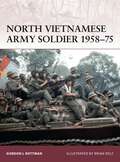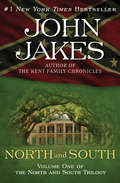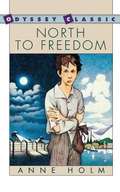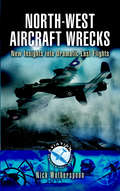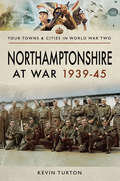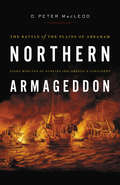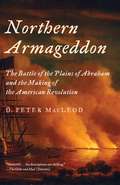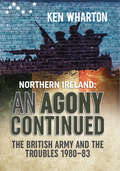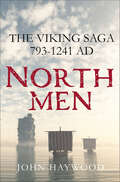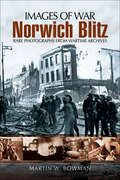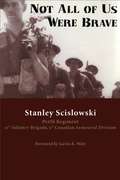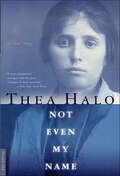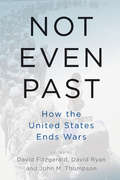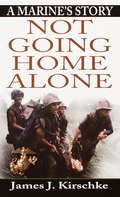- Table View
- List View
North Vietnam's 1972 Easter Offensive: Hanoi's Gamble (Cold War, 1945–1991)
by Stephen EmersonA history of the military campaign that set the stage for the end of the Vietnam War. By the end of 1971, in what Hanoi called the American War and at the height of the Cold War, the fighting had dragged on for eight years with neither side gaining a decisive advantage on the battlefield and talks in Paris to the end the war were going nowhere. While the United States was steadily drawing down its ground forces in South Vietnam, Washington was also engaging in a grand effort to build up and strengthen Saigon&’s armed forces to the point of self-sufficiency. Not only had the ranks of Saigon&’s forces swelled in recent years, but they were now being equipped and trained to use the latest American military equipment. Perhaps now was the time for Hanoi to take one last gamble before it was too late. With the rumble of men and mechanized equipment breaking the early morning silence, some 40,000 North Vietnamese troops advanced across the demilitarized zone into South Vietnam on March 30, 1972, in what would become the largest conventional attack of the war. Ill-prepared and poorly led, South Vietnamese troops in the far north were quickly routed in the face of the ensuing onslaught. Likewise, coordinated attacks across the Cambodian border northwest of Saigon and into the central highlands in the coming weeks gained steam and in due course as many as 200,000 men along with T-54/55 main battle tanks, 130mm towed artillery, ZSU-57 self-propelled ant-aircraft guns, and hundreds of trucks and armored personnel carriers were engaged across three battlefronts. Soon Saigon&’s beleaguered forces were being pushed to the brink of defeat in what appeared to be the end for the Thieu government. Ultimately, however, the timely and massive intervention by U.S. and South Vietnamese air power, along with the bravery of some South Vietnamese commanders and their American advisers saved the day. Hanoi&’s gamble had failed and, in its wake, lay up to 100,000 dead and South Vietnamese roads littered with the smoldering wrecks of North Vietnamese military equipment. Moreover, it would be another three years before the North had recovered enough to try again. &“Informatively presents an episode of the Vietnam War that has otherwise lapsed into obscurity, crowed out of the history books by North Vietnam&’s ultimate victory against the U.S. and South Vietnamese military.&” —Midwest Book Review &“The lessons from Hanoi&’s military victory, which are discussed in this book, still echo in today&’s U.S. military intervention in Afghanistan, so this book&’s account is especially pertinent in understanding the current predicaments facing the U.S. in that troubled country.&” —Journal of Counterterrorism & Homeland Security International
North Vietnamese Army Soldier 1958-75
by Gordon Rottman Brian DelfThe North Vietnamese Army is often forgotten by the histories of the Vietnam War (1955-1975). Commonly mistaken for the locally raised Viet Cong guerrillas, the NVA was in fact an entirely different force for the Democratic Republic of Vietnam. After first supporting the VC in the Republic of Vietnam in 1958, the NVA entered into their own violent armed struggle as the war escalated. Entire divisions and vast numbers of NVA troops were sent south, conducting large-scale operations in a conventional war fought almost entirely by the NVA, and not the VC, as is often believed. Despite limited armor, artillery and air support, the NVA were an extremely politicized and professional force with strict control measures and leadership concepts - soldiers were expected to be totally committed to the cause, and to sacrifice all to ensure its success. Gordon Rottman follows the fascinating life of the highly motivated infantryman from conscription and induction through training to real combat experiences. Covering the evolution of the forces from 1958 onwards, this book takes an in-depth look at the civilian and military lives of the soldiers, while accompanying artwork details the uniforms, weapons and equipment used by the NVA in their clash against America and her allies.
North and South: North And South, Love And War, And Heaven And Hell (The North and South Trilogy #1)
by John JakesThe first volume of John Jakes&’s acclaimed and sweeping saga about a friendship threatened by the divisions of the Civil WarIn the years leading up to the Civil War, one enduring friendship embodies the tensions of a nation. Orry Main from South Carolina and George Hazard from Pennsylvania forge a lasting bond while training at the United States Military Academy at West Point. Together they fight in the Mexican-American War, but their closeness is tested as their regional politics diverge. As the first rounds are fired at Fort Sumter, Orry and George find themselves on different sides of the coming struggle. In John Jakes&’s unmatched style, North and South launches a trilogy that captures the fierce passions of a country at the precipice of disaster.This ebook features an illustrated biography of John Jakes including rare images from the author&’s personal collection.
North to Freedom
by Anne Holm L. W. KingslandAfter escaping from an Eastern European concentration camp where he has spent most of his life, a twelve-year-old boy struggles to cope with an entirely savage world as he flees northward to freedom in Denmark.
North-West Aircraft Wrecks: New Insights into Dramatic Last Flights (Aviation Heritage Trail)
by Nick WotherspoonThis is a different approach to Aviation Archaeology. The book includes 18 crash sites and each chapter includes a description of how the incident occurred and the reasons behind the crash. Copious notes then reveal what the authors have discovered about the artifacts and the history surrounding the cause of the event. Contact with surviving relatives or fellow comrades has in many instances revealed new information and gives a more detailed insight into the geographical location itself. Each chapter will be illustrated to show the site, wreckage and objects found, the crew involved and aircraft type. In addition there will be location information. The appendices will give outline only information on some 400 other incidents, date, location, aircraft type, crew, fate etc.
Northampton in the Great War
by Kevin TurtonWhen war was declared in August 1914, Northampton was swept by a wave of patriotism. Men clamoured to join the ranks and fight in a war they believed would be short lived. There was a sense of excitement, with everyone wanting to do their bit for the country. They believed it was to be a glorious war and thousands, eager to be a part of it, queued outside the recruitment stations to enlist.As that excitement subsided and the town settled into life at war, what really happened in Northampton? How did people react? What did they do and how did it affect their lives? This book describes in meticulous detail exactly what happened in those five years of the Great War and its impact on the town.From the fevered excitement of the early months of war, through to the hope and expectation at its end, this is the story of Northampton's remarkable people and how they helped Belgian refugees who had fled the German invasion, organized fundraising events for the troops and local hospitals, accepted soldiers of the Welsh Fusiliers into their homes and worked long hours producing boots for the army. Against a background of key military events, the book celebrates the huge contribution Northampton and all its people made towards the countrys war effort. It documents a war the like of which no one had ever seen before
Northamptonshire at War, 1939–45 (Your Towns & Cities in World War Two)
by Kevin TurtonWhen the Second World War was declared in September 1939, Northamptonshire was better prepared for the years that followed than it had been twenty-five years earlier. Lessons had been learned from the First World War, and people were far more aware of the impact modern warfare could have on their lives. Through film, press and radio, they were able to monitor the events in Europe in a way unprecedented by any previous generation, which led to a greater understanding of world politics and a realization that the rise to power of Adolf Hitler would have predictable repercussions. So, when Prime Minister Neville Chamberlain addressed the nation after Germanys armies had invaded Poland, war, for many, had already become inevitable.But what exactly did this mean to the people of Northamptonshire, and how did they react to the threat of invasion? What were the consequences of the conflict on the Home Front? How did Northamptonshire's towns and villages function through six years of grinding warfare? These questions, and many others, are examined and answered in the pages of this book.This is the story of those who were there; the people who never accepted the possibility of defeat, who coped with rationing, blackouts, conscription and aerial bombardment, and then welcomed London's evacuees and greeted the American Air Force with open-armed hospitality.Using military events as a background, this book relates Northamptonshire's story, from the parts played in the war effort by the shoe industry, the Northamptonshire Regiment, the Home Guard, the ARP and to, of course, the people.
Northern Armageddon
by D. Peter MacleodThe Battle of the Plains of Abraham is one of the pivotal events in North American and global history. This clash between British General James Wolfe and French General Louis-Joseph de Montcalm on September 13, 1759, led to the British victory in the Seven Years' War in North America, which in turn led to the creation of Canada and the United States as we know them today.Rooted in original research, featuring quotations and images that have never appeared before, Northern Armageddon immerses the reader in the campaign, battle and siege through the eyes of dozens of participants, such as British sailor William Hunter, four Quebec residents enduring the bombing of their city and a teenage Huron warrior. Shifting from perspective to perspective, we move from the bombardment of Quebec to the field of combat, where Montcalm and Wolfe gave their orders but thousands of individual soldiers determined the outcome of the battle. In the final chapters, D. Peter MacLeod traces the battle's impact on Canada, the United States, both countries' Aboriginals and the world, from 1759 into the twenty-first century.
Northern Armageddon: The Battle of the Plains of Abraham and the Making of the American Revolution
by D. Peter MacleodA huge, ambitious re-creation of the eighteenth-century Battle of the Plains of Abraham, the pivotal battle in the Seven Years' War (1754-1763) to win control of the trans-Appalachian region of North America, a battle consisting of the British and American colonists on one side and the French and the Iroquois Confederacy on the other, and leading directly to the colonial War of Independence and the creation of Canada. It took five years of warfare fought on three continents--Europe, Asia, and North America--to bring the forces arrayed against one another--Britain, Prussia, and Hanover against France, Austria, Sweden, Saxony, Russia, and Spain (Churchill called it "the first world war")--to the plateau outside Quebec City, on September 13, 1759, on fields owned a century before by a fisherman named Abraham Martin . . . It was the final battle of a three-month siege by the British Army and Navy of Quebec, the walled city that controlled access to the St. Lawrence River and the continent's entire network of waterways; a battle with the British utilizing 15,000 soldiers, employing 186 ships, with hundreds of colonists aboard British warships and transports from Boston, New York, and Philadelphia, with France sending in a mere 400 reinforcements in addition to its 3,500 soldiers. The battle on the Plains of Abraham lasted twenty minutes, and at its finish the course of a continent was changed forever . . . New military tactics were used for the first time against standard European formations . . . Generals Wolfe and Montcalm each died of gunshot wounds . . . France surrendered Quebec to the British, setting the course for the future of Canada, paving the way for the signing of the Treaty of Paris that gave the British control of North America east of the Mississippi, and forcing France to relinquish its claims on New Orleans and to give the lands west of the Mississippi to Spain for surrendering Florida to the British. After the decisive battle, Britain's maritime and colonial supremacy was assured, its hold on the thirteen American colonies tightened. The American participation in ousting the French as a North American power spurred the confidence of the people of New York, Pennsylvania, and Massachusetts, who began to agitate for independence from Great Britain. Sixteen years later, France, still bitter over the loss of most of its colonial empire, intervened on behalf of the patriots in the American Revolutionary War (1775-1783). In Northern Armageddon, Peter MacLeod, using original research--diaries, journals, letters, and firsthand accounts--and bringing to bear all of his extensive knowledge and grasp of warfare and colonial North American history, tells the epic story on a human scale. He writes of the British at Quebec through the eyes of a master's mate on one of the ships embroiled in the battle. And from the French perspective, as the British bombarded Quebec, of four residents of the city--a priest, a clerk, a nun, and a notary--caught in the crossfire. MacLeod gives us as well the large-scale ramifications of this clash of armies, not only on the shape of North America, but on the history of Europe itself.A stunning work of military history.
Northern Armageddon: The Battle of the Plains of Abraham and the Making of the American Revolution
by D. Peter MacleodA huge, ambitious re-creation of the eighteenth-century Battle of the Plains of Abraham, the pivotal battle in the Seven Years’ War (1754–1763) to win control of the trans-Appalachian region of North America, a battle consisting of the British and American colonists on one side and the French and the Iroquois Confederacy on the other, and leading directly to the colonial War of Independence and the creation of Canada. It took five years of warfare fought on three continents—Europe, Asia, and North America—to bring the forces arrayed against one another—Britain, Prussia, and Hanover against France, Austria, Sweden, Saxony, Russia, and Spain (Churchill called it “the first world war”)—to the plateau outside Quebec City, on September 13, 1759, on fields owned a century before by a fisherman named Abraham Martin . . . It was the final battle of a three-month siege by the British Army and Navy of Quebec, the walled city that controlled access to the St. Lawrence River and the continent’s entire network of waterways; a battle with the British utilizing 15,000 soldiers, employing 186 ships, with hundreds of colonists aboard British warships and transports from Boston, New York, and Philadelphia, with France sending in a mere 400 reinforcements in addition to its 3,500 soldiers. The battle on the Plains of Abraham lasted twenty minutes, and at its finish the course of a continent was changed forever . . . New military tactics were used for the first time against standard European formations . . . Generals Wolfe and Montcalm each died of gunshot wounds . . . France surrendered Quebec to the British, setting the course for the future of Canada, paving the way for the signing of the Treaty of Paris that gave the British control of North America east of the Mississippi, and forcing France to relinquish its claims on New Orleans and to give the lands west of the Mississippi to Spain for surrendering Florida to the British. After the decisive battle, Britain’s maritime and colonial supremacy was assured, its hold on the thirteen American colonies tightened. The American participation in ousting the French as a North American power spurred the confidence of the people of New York, Pennsylvania, and Massachusetts, who began to agitate for independence from Great Britain. Sixteen years later, France, still bitter over the loss of most of its colonial empire, intervened on behalf of the patriots in the American Revolutionary War (1775–1783). In Northern Armageddon, Peter MacLeod, using original research—diaries, journals, letters, and firsthand accounts—and bringing to bear all of his extensive knowledge and grasp of warfare and colonial North American history, tells the epic story on a human scale. He writes of the British at Quebec through the eyes of a master’s mate on one of the ships embroiled in the battle. And from the French perspective, as the British bombarded Quebec, of four residents of the city—a priest, a clerk, a nun, and a notary—caught in the crossfire. MacLeod gives us as well the large-scale ramifications of this clash of armies, not only on the shape of North America, but on the history of Europe itself.A stunning work of military history.
Northern Ireland: The British Army and the Troubles 1980–83
by Ken WhartonThis book is called ‘An Agony Continued’ because it was simply that: an agony. It was an agony which commenced at the end of the 1960s and as the new decade of the 80s arrived, so the pain, the grief, the loss and the economic destruction of Northern Ireland continued. Little did any of us know at the time, but it was to do so for almost a further two decades. Between January 1980 and December 1989, around 1,000 people died; many were soldiers and policemen; some were Prison Officers; some were paramilitaries; and some were innocent civilians. The Provisional IRA (PIRA) and their slightly more psychopathic cousins in the Irish National Liberation Army (INLA) would continue to kill innocent civilians by the score during this decade. Across the sectarian divide the Ulster Freedom Fighters (UFF) and the equally vicious Ulster Volunteer Force (UVF) would continue to slaughter Catholics in streets, in pubs and in restaurants. This book will look at the period which encompassed the 48 months of 1980 and 1983. It was a near half-decade which saw the Hyde Park and Regent’s Park massacre of soldiers and horses from the Blues and Royals and the cowardly bombing of the Royal Green Jackets’ band. It further witnessed the murder of 18 people by the INLA at a disco held in the Droppin’ Well in Ballykelly and also the death of the leader of the Shankill Butchers: Lenny Murphy. The years under study include the 1981 deaths of ten Republican paramilitaries who starved themselves to death in protest against the loss of their status as ‘political prisoners'. As ever, this book pulls no punches in its absolute detestation of both Republican and Loyalist paramilitaries. This book continues Ken Wharton's epic journey through the Troubles in Northern Ireland, viewed primarily through the eyes of the British Army squaddies on the ground.
Northern Rebel and Daring in the Dark
by Jennifer LaBrecque2 Complete Novels for 1 Price! Northern Rebel: A new sizzling Uniformly Hot storyLocate the explosive. Defuse or safely detonate it. It's a job that takes cojones, and one wrong move could land marine demolitions expert Lars Reinhardt in the hurt locker...or in the morgue. But it takes a leave in Good Riddance, Alaska, for Lars to meet his greatest-and prickliest-challenge yet. And he'll need more than charm to disarm this stunning nurse....Delphi Reynolds has declared that emotionally unavailable dudes are the new no-no. And while she's tempted to let Lars light her libido's fuse, he's off-limits-no matter how sexy, charming or freakin' gorgeous he is! But Lars lives for a challenge, and he wants Delphi for the week. And once they ignite, it'll set off a fiery chain reaction that could blow them both away....Reader favorite Daring in the Dark: What's a guy to do when he's in love with his best friend's girl? Not much...until a blackout allows him-and his girl-to see the light....
Northern Thunder: A William Parker Mission (A Will Parker Thriller #1)
by Anderson HarpINTO THE LION&’S DEN North Korea. For Kim Jong-un, the time has come to position his country atop the world&’s pecking order. To do so, he has invested his nation&’s resources in one rogue scientist. Peter Nampo is a nanotech specialist who has developed a nuclear missile not only capable of reaching the heart of Los Angeles, but also capable of knocking out America&’s eyes in the skies—the GPS satellites overseeing the Korean Peninsula. Jong-un has funded Nampo&’s secret laboratory somewhere in a valley of the Taebaek Mountains. Marine recon veteran and small town prosecutor William Parker has a history with Peter Nampo—and is the only one who can identify him. Recruited into a joint CIA and Pentagon Dark Ops Taskforce, Parker must infiltrate the Hermit Kingdom, find Nampo, and end the scientist&’s threat. But there&’s more to this mission than Parker knows, and what he discovers is a danger far greater than being trapped behind enemy lines . . . Praise for RETRIBUTION &“I seldom come across a thriller as authentic and well‑written as Retribution. Andy Harp brings his considerable military expertise to a global plot that&’s exciting, timely, and believable . . . to say that I&’m impressed is an understatement.&”—David Morrell, New York Times bestselling author of The Protector &“Retribution is a stunner: a blow to the gut and shot of adrenaline. Here is a novel written with authentic authority and bears shocking relevance to the dangers of today. It reminds me of Tom Clancy at his finest.&”—James Rollins, New York Times bestselling author of Bloodline &“Outstanding thriller with vivid characters, breakneck pacing, and suspense enough for even the most demanding reader. Harp writes with complete authenticity and a tremendous depth of military knowledge. A fantastic read—don&’t miss it!&”—Douglas Preston, #1 bestselling author of Impact
Northern Thunder: A William Parker Mission (A Will Parker Thriller #1)
by Anderson HarpINTO THE LION&’S DEN North Korea. For Kim Jong-un, the time has come to position his country atop the world&’s pecking order. To do so, he has invested his nation&’s resources in one rogue scientist. Peter Nampo is a nanotech specialist who has developed a nuclear missile not only capable of reaching the heart of Los Angeles, but also capable of knocking out America&’s eyes in the skies—the GPS satellites overseeing the Korean Peninsula. Jong-un has funded Nampo&’s secret laboratory somewhere in a valley of the Taebaek Mountains. Marine recon veteran and small town prosecutor William Parker has a history with Peter Nampo—and is the only one who can identify him. Recruited into a joint CIA and Pentagon Dark Ops Taskforce, Parker must infiltrate the Hermit Kingdom, find Nampo, and end the scientist&’s threat. But there&’s more to this mission than Parker knows, and what he discovers is a danger far greater than being trapped behind enemy lines . . . Praise for RETRIBUTION &“I seldom come across a thriller as authentic and well‑written as Retribution. Andy Harp brings his considerable military expertise to a global plot that&’s exciting, timely, and believable . . . to say that I&’m impressed is an understatement.&”—David Morrell, New York Times bestselling author of The Protector &“Retribution is a stunner: a blow to the gut and shot of adrenaline. Here is a novel written with authentic authority and bears shocking relevance to the dangers of today. It reminds me of Tom Clancy at his finest.&”—James Rollins, New York Times bestselling author of Bloodline &“Outstanding thriller with vivid characters, breakneck pacing, and suspense enough for even the most demanding reader. Harp writes with complete authenticity and a tremendous depth of military knowledge. A fantastic read—don&’t miss it!&”—Douglas Preston, #1 bestselling author of Impact
Northmen: The Viking Saga, 793–1241 AD
by John HaywoodThis sweeping medieval history follows the Vikings from Finland to Newfoundland, from Jelling to Jerusalem, and from paganism to Christendom.In AD 800, the Scandinavians were just barbarians in longships. Though they held sway in the north, their status was based on their ability to pillage and plunder. As these Norse warriors left their strongholds to trade, raid, and settle across wide areas of Europe, Asia, and the North Atlantic, their violent and predatory culture left a unique imprint on medieval history. But in time, contact with these new territories would leave an indelible mark on the Vikings as well.By the year 1200, what remained of the Vikings’ pagan origins floated beneath the surface and the strong, strange territories of the north had become a part of Latin Christendom. In Northmen, medieval historian John Haywood chronicles this transformation, paying homage to what was lost and celebrating what was won. Focusing on key events, including the sack of Lindisfarne in 793 and the Battle of Stamford Bridge in 1066, Haywood recounts the saga of the Viking Age, from the creation of the world through to the dwindling years of halfhearted raids and elegiac storytelling in the thirteenth century.
Northrop Flying Wings
by Graham M. SimonsThe aviation historian and author of Memphis Belle presents an authoritative analysis of the groundbreaking, post-WWI series of military aircraft. In the years following the First World War, a new imperative arose in aviation technology: stealth, speed, and precision. American aircraft designer Jack Northrop developed a streamlined craft that did away with superfluous appendages, including the weighty fuselage and tail units. This was an extreme measure, but Northrop was determined to push aircraft design to a new level. Eliminating both the fuselage and tail meant placing the pilot, the engines, and the payload entirely within the wing envelope. The resulting craft, Northrop&’s flying wings, were some of the most spectacular machines ever to grace the skies. With barely any vertical surfaces at all, they looked like something from the realm of science fiction. Indeed, one even appeared in the film version of H.G. Wells&’ War of the Worlds. Written off by many as a mere novelty, the development of these unique bombers provided aeronautical innovations that paved the way for a raft of new designs. During the 1970s, when the United States needed a new strategic bomber to replace the B-52 Superfortress, the flying wing design was brought to the fore once again. The B-2 Spirit was born out of this, continuing the legacy of this stealthy design. This craft, along with the B-35, the eight-engined YB-49 and the YRB-49A, are all highlighted in this authoritative history. Detailed analyses of each design, set within a wider historical context, make for a compelling record of this landmark design.
Norwich Blitz: Rare Photographs from Wartime Archives (Images of War)
by Martin W. BowmanNorwich, in common with most English cities, suffered enemy air attack and during a period of almost three and a half years bombs were dropped in every part of the city. The first German raid occurred on Tuesday 8 July 1940; the last on 6 November 1943. The total number of Alerts during 1943 was 95 with a total duration of 54 hours. The Crash Warning was sounded 50 times with a total duration of 19 hours 8 minutes. There was no large devastated area but throughout the city considerable damage was caused. All sections of life were affected and factories, railway stations, shops, schools, hospitals and churches sustained damage and many buildings were totally ruined. Of the citys 35,569 houses in 1939, 2,082 were destroyed entirely, 2,651 were seriously damaged and 25,621 were moderately damaged. In human toll 340 people were killed and 1,092 injured, over three-quarters of these casualties occurring in 1942 when the enemy carried out what became known as the Baedeker Raids upon Cathedral cities and historic and administrative capitals of the provinces.
Norwich in the Great War (Your Towns & Cities in the Great War)
by Stephen BrowningOn the eve of the Great War, Norwich was very much a city on the rise an industrial and commercial powerhouse. It was certainly not, however, without its problems, not least the extreme poverty of some areas, such as the notorious Norwich Yards. This meticulously researched book looks at Norwich on the eve of conflict and charts, in detail, everyday life in the city, year on year, extensively drawing on original material from the period much of it never before published in book form. It largely focuses on how it felt to live in the city: on the joys and trials, on the changes to peoples lives, on the courage and humour, as well as the pride and determination shown by the people of The Fine City. Both dramatic events and the details of daily life are illustrated by many rare and fascinating photographs taken at the time. The massive contribution that Norwich's industry made to the war effort especially in supplying hundreds of thousands of pairs of the perfect marching boot and in building the Sopwith Camel on Riverside is celebrated. As are the incredible deeds of the heroes who travelled from Norwich to the fields of conflict, some of whom gained the Victoria Cross and the many more brave men who did not. Usefully, an At a Glance section outlines the main world events against which home life unfolded. It concludes with a view of the city as the surviving troops finally came home. A separate appendix gives the route for a fascinating 'Great War Walk' around the city centre, taking in many of the places discussed throughout this book.
Nos robaron la juventud: Memoria viva de la Quinta del biberón
by Victor AmelaNos robaron la juventud narra las historias de los biberones que combatieron en el Ebro, de los voluntarios que se alistaron siendo apenas adolescentes (tanto en el ejército republicano como en el de Franco), de los que sobrevivieron y (algunos) continuaron su lucha en la Segunda Guerra Mundial, de los que fueron encarcelados y de los que fallecieron en el campo de batalla. Hacia el final de la Guerra Civil, 27.000 muchachos nacidos en 1920 fueron llamados a filas. Se los conoció como la Quinta del Biberón y muchos ni siquiera tenían dieciocho años cuando perdieron la vida en la sangrienta batalla del Ebro. Los supervivientes acabaron en penales y en cárceles franquistas, en campos de concentración o en batallones disciplinarios, y debieron cumplir luego un largo servicio militar. Todos conservaron de por vida el terrible recuerdo de esa guerra en la que combatieron en alpargatas y sin cartucheras. La sarna, los piojos, la sed, las caminatas, la metralla. Las voces quebradas de los chiquillos moribundos en el campo de batalla llamando a sus madres. Los compañeros muertos, enterrados a centenares en la Venta de les Camposines. Una pesadilla repetida noche tras noche a lo largo de los años en el momento de cerrar los ojos. La certeza de que les habían robado la juventud. Víctor Amela ha recopilado el valioso testimonio de veinticinco supervivientes y ha reconstruido con una minuciosa investigación la memoria de esos muchachos que vivieron uniformados de los diecisiete a los veinticinco años. Y estas conmovedoras historias humanas se alzan -gracias al rigor periodístico del autor y a su pasión al narrar los hechos- en el debido y sentido homenaje a los héroes anónimos de la Quinta del Biberón cuando se cumple el centenario de sus nacimientos.
Not All of Us Were Brave
by Stanley ScislowskiThis is the story of a young man’s journey through World War II. It covers a wide cross section of the strengths and weaknesses of young men not attuned to killing, and not mentally prepared to face the horror of seeing their close friends die violent deaths in battle. The story is about the hopes, the prayers, the fears, the daily miseries and even the lighter moments that the aspiring heroes of the Perth Regiment experienced on the Italian front as part of 11th Infantry Brigade, 5th Canadian Armoured Division.As the title suggests, from his first battle inoculation Private Stan Scislowski realizes he is not destined for the heroic role to which he once aspired. His fears affect him deeply: his burning dream of returning home a national hero becomes more and more improbable, and his attempts to come to terms with his un-heroic nature make the war as much a mental battle as a physical one. His story is much like that of the overwhelming number of Canadians who found themselves in the cauldron of war, serving their country with all the strength they could find, even when that strength was fading fast.Not All of Us Were Brave focuses not on the heroes, but on the ordinary soldiers who endured the mud, the misery, the ever-present fear, the inspiration, and the degradation. The narrative holds nothing back: the dirty linen is aired along with the clean; the light is shown alongside the dark. It shows what war is all about.
Not Even My Name: A True Story
by Thea Halo“The harrowing story of the slaughter of two million Pontic Greeks and Armenians in Turkey after WWI comes to vivid life. . . . eloquent and powerful.” —Publishers WeeklyNot Even My Name exposes the genocide carried out during and after WWI in Turkey, which brought to a tragic end the 3000-year history of the Pontic Greeks (named for the Pontic Mountain range below the Black Sea). During this time, almost 2 million Pontic Greeks and Armenians were slaughtered and millions of others were exiled.Not Even My Name is the unforgettable story of Sano Halo’s survival, as told to her daughter, Thea, and of their trip to Turkey in search of Sano’s home seventy years after her exile. Sano Halo was a 10-year-old girl when she was torn from her ancient, pastoral way of life in the mountains and sent on a death march that annihilated her family. Stripped of everything she had ever held dear, even her name, Sano was sold by her surrogate family into marriage when she was fifteen to a man three times her age.Not Even My Name follows Sano’s marriage, the raising of her ten children in New York City and her transformation from an innocent girl to a nurturing mother and determined woman in twentieth-century New York City.“An important and revealing book.” —Library Journal“What illuminates the writing is Halo’s heartfelt love for her brave mother. An unforgettable book.” —Booklist
Not Even Past: How the United States Ends Wars
by David Fitzgerald John M. Thompson David RyanVietnam, Iraq, Afghanistan: Taken together, these conflicts are the key to understanding more than a half century of American military history. In addition, they have shaped, in profound ways, the culture and politics of the United States—as well as the nations in which they have been fought. This volume brings together international experts on American history and foreign affairs to assess the cumulative impact of the United States’ often halting and conflicted attempts to end wars. It offers essential perspectives on the Cold War and post-9/11 eras and explores the troubling implications of the American tendency to fight wars without end.
Not Forgotten: The Great War and Our Modern Memory
by Neil OliverThere are 37,780 First World War memorials in Britain, listing names from all walks of life - estates, villages, places of work. They stand as landmarks to a defining period in British history - and yet one which is in danger of slipping away from popular memory. NOT FORGOTTEN is a revealing look at the untold stories that lie behind these lists of names - stories of the impact of World War One on British society, the echoes of which can still be felt today. More than a conflict overseas, it was the catalyst for an extraordinary period of rapid and radical change to the social, cultural and political fabric of the nation. Social restrictions on women were revolutionised, from jobs and the vote to new freedoms in dress, behaviour and sexuality. The class system was thrown into disarray, both at home and on the front lines; roles were reversed in family life for a large part of the population, through bereavement, evacuation and children put to work in munitions factories. And as the state took drastic measures to cope with this turmoil, so the foundations were laid for the society in which we live today.
Not Forgotten: The Great War and Our Modern Memory
by Neil OliverThere are 37,780 First World War memorials in Britain, listing names from all walks of life - estates, villages, places of work. They stand as landmarks to a defining period in British history - and yet one which is in danger of slipping away from popular memory. NOT FORGOTTEN is a revealing look at the untold stories that lie behind these lists of names - stories of the impact of World War One on British society, the echoes of which can still be felt today. More than a conflict overseas, it was the catalyst for an extraordinary period of rapid and radical change to the social, cultural and political fabric of the nation. Social restrictions on women were revolutionised, from jobs and the vote to new freedoms in dress, behaviour and sexuality. The class system was thrown into disarray, both at home and on the front lines; roles were reversed in family life for a large part of the population, through bereavement, evacuation and children put to work in munitions factories. And as the state took drastic measures to cope with this turmoil, so the foundations were laid for the society in which we live today.
Not Going Home Alone
by James J. KirschkeExperience the pain, the pride, and the triumph of the Marine Corps All the members of 1st Lt. James J. Kirschke’s mortar platoon and then rifle platoon knew the stakes: the Marines are America’s military elite, expected to train harder, fight longer, sacrifice more. Kirschke led by example in the hotly contested zone just south of the DMZ and in the dangerous AnHoa region southwest of DaNang. There Kirschke’s units, with resources stretched to the limit, saw combat almost daily in some of the fiercest fighting of 1966. Sustained through the toughest firefights and bloodiest ambushes, the men’s morale proved a testament to Kirschke’s leadership and his dedication to what the U. S. Marines stand for. Those beliefs, and the faith of his men, in turn helped Kirschke through his long recovery after he was wounded by the triple explosion of a box mine rigged to an anti-tank rocket round and a frag grenade. The Marines’ legend and reputation are based on the blood, courage, and discipline of warriors like Jim Kirschke. Sparing no one, he has written a powerful chronicle of the deadly war his Marines fought with valor.

